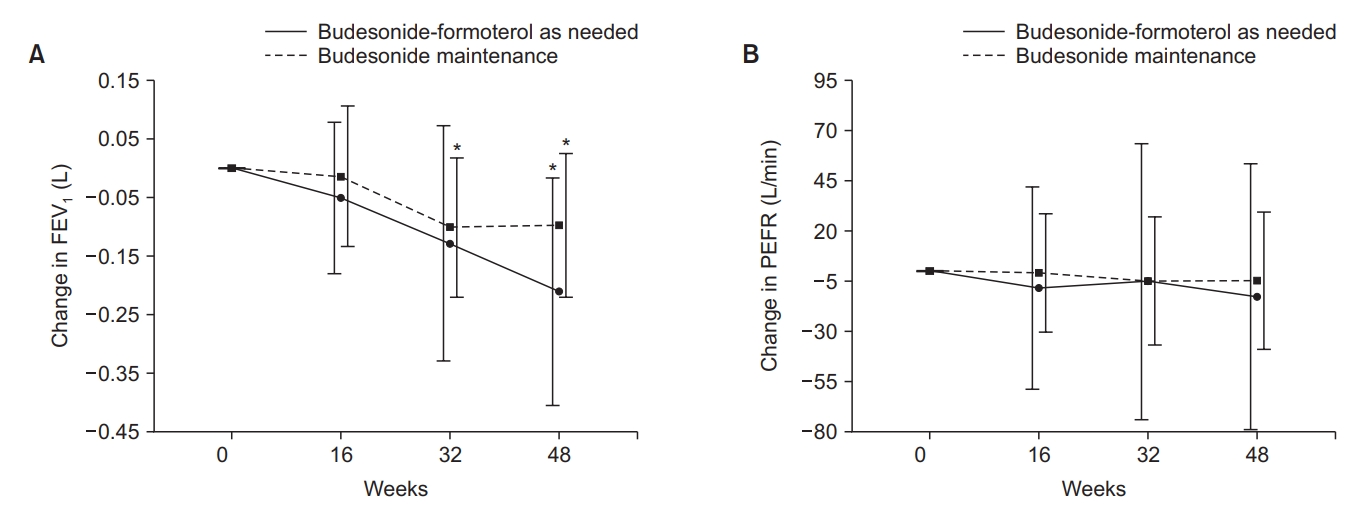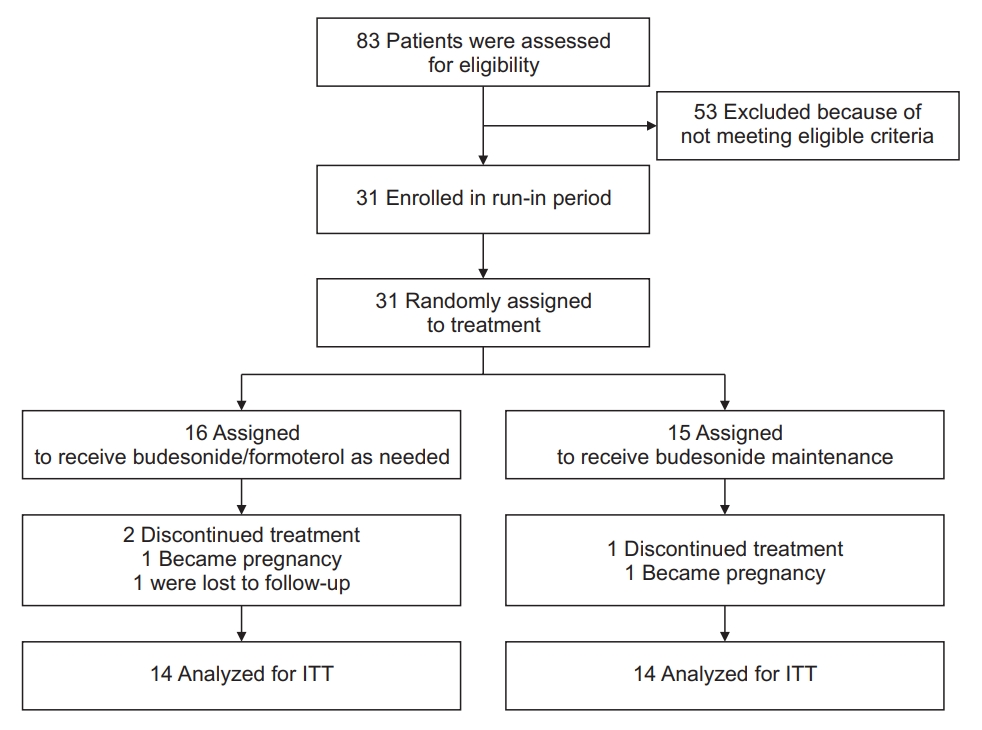1. Global Initiative for Asthma (GINA). Global strategy for asthma management and prevention, updated 2020 [Internet]. Fontana: Global Initiative for Asthma; 2020 [cited 2020 Jan 1]. Available from:
http://www.ginasthma.org.
3. Mori K, Fujisawa T, Inui N, Hashimoto D, Enomoto N, Nakamura Y, et al. Step-down treatment from medium-dosage of budesonide/formoterol in controlled asthma. Respir Med 2016;119:1-6.


4. Nakwan N, Perkleang T, Tamsawai T, Taptawee P, Usaha S. A 12-week, randomized, parallel-group, phase III study comparing the efficacy of once-daily budesonide/formoterol turbuhaler (160/4.5 mug/d) with twice-daily budesonide (400 mug/d) during the step-down period in well-controlled asthma. Turk Thorac J 2018;19:66-72.


5. Kim SH, Lee T, Jang AS, Park CS, Jung JW, Kim MH, et al. Pragmatic randomized controlled trial for stepping down asthma controller treatment in patients controlled with low-dose inhaled corticosteroid and long-acting beta2-agonist: step-down of intervention and grade in moderate asthma study. J Allergy Clin Immunol Pract 2021;9:3638-46.

6. Bateman ED, Reddel HK, O’Byrne PM, Barnes PJ, Zhong N, Keen C, et al. As-needed budesonide-formoterol versus maintenance budesonide in mild asthma. N Engl J Med 2018;378:1877-87.


7. O’Byrne PM, FitzGerald JM, Bateman ED, Barnes PJ, Zhong N, Keen C, et al. Inhaled combined budesonide-formoterol as needed in mild asthma. N Engl J Med 2018;378:1865-76.


8. Beasley R, Holliday M, Reddel HK, Braithwaite I, Ebmeier S, Hancox RJ, et al. Controlled trial of budesonide-formoterol as needed for mild asthma. N Engl J Med 2019;380:2020-30.


9. Hardy J, Baggott C, Fingleton J, Reddel HK, Hancox RJ, Harwood M, et al. Budesonide-formoterol reliever therapy versus maintenance budesonide plus terbutaline reliever therapy in adults with mild to moderate asthma (PRACTICAL): a 52-week, open-label, multicentre, superiority, randomised controlled trial. Lancet 2019;394:919-28.

11. FitzGerald JM, Arnetorp S, Smare C, Gibson D, Coulton K, Hounsell K, et al. The cost-effectiveness of as-needed budesonide/formoterol versus low-dose inhaled corticosteroid maintenance therapy in patients with mild asthma in the UK. Respir Med 2020;171:106079.


13. Niyatiwatchanchai N, Chaiwong W, Pothirat C. The validity and reliability of the Thai version of the asthma control test. Asian Pac J Allergy Immunol 2021 Jan 2 [Epub].
https://doi.org/10.12932/AP-130820-0940.

14. Juniper EF, O’Byrne PM, Guyatt GH, Ferrie PJ, King DR. Development and validation of a questionnaire to measure asthma control. Eur Respir J 1999;14:902-7.


15. Juniper EF, Bousquet J, Abetz L, Bateman ED; GOAL Committee. Identifying ‘well-controlled’ and ‘not well-controlled’ asthma using the Asthma Control Questionnaire. Respir Med 2006;100:616-21.


16. Juniper EF, Svensson K, Mork AC, Stahl E. Measurement properties and interpretation of three shortened versions of the asthma control questionnaire. Respir Med 2005;99:553-8.


18. Price DB, Rigazio A, Campbell JD, Bleecker ER, Corrigan CJ, Thomas M, et al. Blood eosinophil count and prospective annual asthma disease burden: a UK cohort study. Lancet Respir Med 2015;3:849-58.


19. Chung KF, Wenzel SE, Brozek JL, Bush A, Castro M, Sterk PJ, et al. International ERS/ATS guidelines on definition, evaluation and treatment of severe asthma. Eur Respir J 2014;43:343-73.

20. Nathan RA, Sorkness CA, Kosinski M, Schatz M, Li JT, Marcus P, et al. Development of the asthma control test: a survey for assessing asthma control. J Allergy Clin Immunol 2004;113:59-65.


21. Schatz M, Sorkness CA, Li JT, Marcus P, Murray JJ, Nathan RA, et al. Asthma Control Test: reliability, validity, and responsiveness in patients not previously followed by asthma specialists. J Allergy Clin Immunol 2006;117:549-56.


22. Standardization of Spirometry, 1994 Update. American Thoracic Society. Am J Respir Crit Care Med 1995;152:1107-36.


24. Kieser M, Wassmer G. On the use of the upper confidence limit for the variance from a pilot sample for sample size determination. Biom J 1996;38:941-9.

26. Menzies-Gow A, Bafadhel M, Busse WW, Casale TB, Kocks JW, Pavord ID, et al. An expert consensus framework for asthma remission as a treatment goal. J Allergy Clin Immunol 2020;145:757-65.


29. Brozek JL, Kraft M, Krishnan JA, Cloutier MM, Lazarus SC, Li JT, et al. Long-acting beta2-agonist step-off in patients with controlled asthma. Arch Intern Med 2012;172:1365-75.


30. Kharitonov SA, Yates DH, Chung KF, Barnes PJ. Changes in the dose of inhaled steroid affect exhaled nitric oxide levels in asthmatic patients. Eur Respir J 1996;9:196-201.


31. Kharitonov SA, Yates DH, Barnes PJ. Inhaled glucocorticoids decrease nitric oxide in exhaled air of asthmatic patients. Am J Respir Crit Care Med 1996;153:454-7.


32. Lonnkvist K, Anderson M, Hedlin G, Svartengren M. Exhaled NO and eosinophil markers in blood, nasal lavage and sputum in children with asthma after withdrawal of budesonide. Pediatr Allergy Immunol 2004;15:351-8.


33. Haahtela T, Tamminen K, Malmberg LP, Zetterstrom O, Karjalainen J, Yla-Outinen H, et al. Formoterol as needed with or without budesonide in patients with intermittent asthma and raised NO levels in exhaled air: a SOMA study. Eur Respir J 2006;28:748-55.


35. Boulet LP. Perception of the role and potential side effects of inhaled corticosteroids among asthmatic patients. Chest 1998;113:587-92.














 PDF Links
PDF Links PubReader
PubReader ePub Link
ePub Link Data Sharing Statement
Data Sharing Statement Full text via DOI
Full text via DOI Print
Print Download Citation
Download Citation



